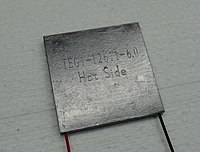
Photo from wikipedia
2D layered materials and heterojunctions with excellent ductility and controllable atomic‐layer thicknesses have shown promise for use in advanced electronics and optical functional devices. Tailoring of nanoscale configurations and physical… Click to show full abstract
2D layered materials and heterojunctions with excellent ductility and controllable atomic‐layer thicknesses have shown promise for use in advanced electronics and optical functional devices. Tailoring of nanoscale configurations and physical properties is essential and required for bespoke fabrication of advanced devices based on 2D materials. Due to the high strain tolerance of 2D layered materials, strain engineering is an effective method to tune their behaviors of electrons and phonons. A wide variety of 2D materials are available with tunable bandgaps from interface coupling effects, making 2D layered heterojunctions a versatile platform for understanding fundamental physical issues. Most physical properties and functional applications can be tailored by applying strain to 2D layered materials and heterostructures to realize a scheduled target in carrier concentration, mobility, and barrier height. Herein, the latest research on the roles of strain in modulating the physical properties of 2D layered materials and heterojunctions is introduced, focusing on the physical properties behind strain modulation in 2D materials. Understanding and manipulating strain in 2D layered materials and heterojunctions is important and beneficial for creating tunable electronic and optoelectronic constructions with advanced components, including functional flexible and wearable devices.
Journal Title: Annalen der Physik
Year Published: 2019
Link to full text (if available)
Share on Social Media: Sign Up to like & get
recommendations!